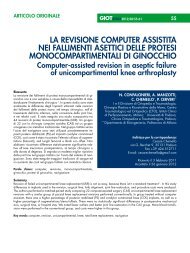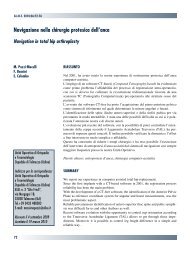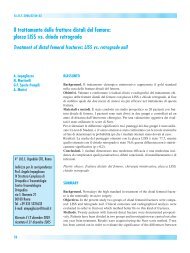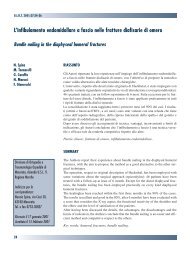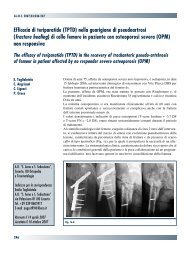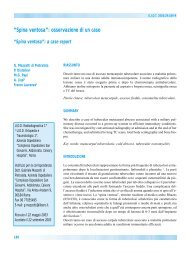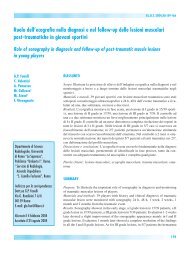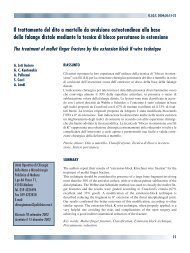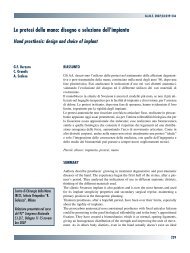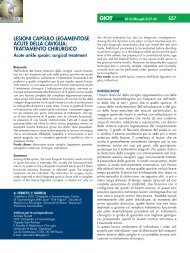Vol.XXXVII, Suppl. 1 - Giornale Italiano di Ortopedia e Traumatologia
Vol.XXXVII, Suppl. 1 - Giornale Italiano di Ortopedia e Traumatologia
Vol.XXXVII, Suppl. 1 - Giornale Italiano di Ortopedia e Traumatologia
You also want an ePaper? Increase the reach of your titles
YUMPU automatically turns print PDFs into web optimized ePapers that Google loves.
s66<br />
agosto2011;37(suppl.1):66-71<br />
risuLtati dEL riVEstiMEnto<br />
con traBEcuLar MEtaL<br />
nELLo stELo fEMoraLE<br />
results of a trabecular Metal-coated<br />
femoral stem<br />
riassunto<br />
obiettivi: Lo stelo protesico femorale Trabecular Metal Primary<br />
(TMP, Zimmer) è costituito da una lega <strong>di</strong> titanio e presenta un<br />
rivestimento prossimale in tantalio con il fine <strong>di</strong> realizzare una<br />
valida fissazione prossimale e favorire un precoce osteintegrazione.<br />
È stato condotto uno stu<strong>di</strong>o multicentrico prospettico per<br />
valutare i risultati clinici e ra<strong>di</strong>ografici preliminari <strong>di</strong> questo innovativo<br />
stelo femorale.<br />
Materiali e meto<strong>di</strong>: Nel periodo <strong>di</strong>cembre 2006-<strong>di</strong>cembre 2008<br />
sono stati impiantati 182 steli TMP. L’età me<strong>di</strong>a dei pazienti era<br />
<strong>di</strong> 68,5 anni (min. 26, max. 92). Le donne erano 95 (57%)<br />
ed i maschi 74 (43%). La patologie primitive prevalenti erano<br />
l’artrosi in 128 anche (70%), fratture collo femore (21%)<br />
ed osteonecrosi (9%). La valutazione clinica è stata eseguita<br />
secondo i parametri dell’Harris Hip Score (HHS). Negli esami<br />
ra<strong>di</strong>ografici nelle proiezioni A/P e L/L a 3- 6-12-24 mesi la<br />
fissazione dello stelo è stata valutata secondo i criteri <strong>di</strong> Engh.<br />
In 80 anche è stata eseguita una valutazione del rimodellamento<br />
osseo periprotesico utilizzando l’esame DEXA (Dual Energy<br />
X-ray Absorptiometry) confrontando le variazioni della densità<br />
minerale ad 1,3,6-12 e 24 mesi dall’intervento chirurgico nelle<br />
7 zone <strong>di</strong> Gruen.<br />
risultati: Abbiamo valutato clinicamente e ra<strong>di</strong>ograficamente i<br />
risultati con un follow-up minimo <strong>di</strong> 24 mesi (me<strong>di</strong>o 39,2- max<br />
50) 180 anche. Il punteggio HHS è passato da un valore preoperatorio<br />
me<strong>di</strong>o <strong>di</strong> 42,4 punti a 83 punti a 6 mesi, 93,4 punti<br />
a 12 mesi, 95,6 punti a 24 mesi (min. 70, max. 100). I risultati<br />
clinici complessivi sono stati giu<strong>di</strong>cati ottimi e buoni in 154 pazienti<br />
(90%). Al controllo clinico a 24 mesi abbiamo riscontrato<br />
la presenza <strong>di</strong> un dolore femorale durante la deambulazione<br />
in 4 pazienti (2,3%) Gli esami ra<strong>di</strong>ografici <strong>di</strong> controllo hanno<br />
evidenziato in tutti i casi un’osteointegrazione dello stelo con<br />
a. caponE, d. Murgia, M. pLanta, c. ManZini * ,<br />
p. gifuni * , E. <strong>di</strong>otti * , E. gasBarra ** ,<br />
r. iundusi ** , u. tarantino **<br />
Clinica Ortope<strong>di</strong>ca e Traumatologica, Università <strong>di</strong> Cagliari;<br />
* U.O. Complessa <strong>di</strong> Ortope<strong>di</strong>a e <strong>Traumatologia</strong>,<br />
A.O. Desio e Vimercate (MB); ** U.O. Complessa<br />
<strong>di</strong> Ortope<strong>di</strong>a e <strong>Traumatologia</strong>, Università <strong>di</strong> Tor Vergata, Roma<br />
In<strong>di</strong>rizzo per la corrispondenza:<br />
Antonio Capone<br />
Clinica Ortope<strong>di</strong>ca, Ospedale Marino<br />
Lungomare Poetto, 09126 Cagliari<br />
Tel./Fax +39 070 372377<br />
E-mail: anto.capone@tiscali.it<br />
comparsa dopo 24 mesi <strong>di</strong> ponti ossei in regione metafisaria nel<br />
100% delle anche e presenza <strong>di</strong> linee <strong>di</strong> ra<strong>di</strong>otrasparenza in<br />
regione 3-4-5 nel 9,4%. L’analisi DEXA ha evidenziato dopo 24<br />
mesi un incremento della densità ossea periprotesica con una<br />
riduzione della BMD del 1,3% in zona 1 e del 11,1% in zona 7<br />
rispetto ai valori postoperatori.<br />
conclusioni: I risultati clinici e ra<strong>di</strong>ografici a breve termine evidenziano<br />
che il <strong>di</strong>segno ed il rivestimento in trabecular metal<br />
dello stelo TMP consentono <strong>di</strong> ottenere una valida stabilità primaria<br />
ed una rapida osteointegrazione in un gruppo <strong>di</strong> 171<br />
pazienti con età me<strong>di</strong>a avanzata (68,5 anni) ed affetti anche da<br />
osteoporosi (fratture collo femore 21%).<br />
parole chiave: artroprotesi d’anca, stelo femorale, trabecular<br />
metal<br />
summary<br />
objective: The Trabecular Metal Primary (TMP Zimmer) stem is<br />
made of a titanium alloy with trabecular metal proximal coating<br />
for improving initial fixation and to enhance bone ingrowth. The<br />
stem design with A/P 14° proximal taper and 3° <strong>di</strong>stal taper<br />
with smooth surface provides a proximal load transfer reducing<br />
stress-shiel<strong>di</strong>ng. A prospective study was conducted to evaluate<br />
the clinical and ra<strong>di</strong>ographic results in 171 patients undergoing<br />
primary total hip arthroplasties (182) between December 2006<br />
and December 2008.<br />
Materials and methods: The mean age of the patients at the<br />
time of arthroplasty was 68,5 years (range 26-92 years). 57%<br />
of the patients were female and 43% were male. The principal<br />
preoperative <strong>di</strong>agnoses were osteoarthritis (70%), femoral<br />
neck fractures (21%) and osteonecrosis (9%). Clinical and ra<strong>di</strong>ographic<br />
evaluations were performed preoperatively and postoperatively<br />
at 1 month, 3 months, 6 months, 12 months and 24<br />
months. Clinical evaluations were collected accor<strong>di</strong>ng to Harris<br />
Hip Score (HHS) criteria. In the ra<strong>di</strong>ographic results the femoral<br />
component fixation was evaluated accor<strong>di</strong>ng to the criteria of<br />
Engh. In ad<strong>di</strong>tion serial DEXA stu<strong>di</strong>es were conducted in 80 hips<br />
to evaluate femoral bone mineral density.<br />
results: We evaluated the results of 180 hips at a minimum 24<br />
month follow-up (average 39,2 m., max. 48 m.) The mean preoperative<br />
average Harris hip score was 42,4 points. It improved<br />
to 83 points by 6 month postoperatively, and to 93,4 points by<br />
12 months. The average HHS at 24 months was 95,6 (range<br />
70-100), and a excellent or good score was recorded for 154<br />
patients (90%). At the time of two-year follow-up the mild thigh<br />
pain persisted in only four patients (2,3%). Ra<strong>di</strong>ographic evaluation<br />
demonstrated at 24-month follow-up no femoral fixation<br />
failures with spot welds seen in all 180 hips. 17 hips (9,4%) had<br />
evidence of ra<strong>di</strong>olucencies in Gruen zones 3-4-5. Dual energy<br />
x-ray absorptiometry performed at 24 months reported an average<br />
total BMD loss of 5,1% with 1,3% in Gruen Zone 1 and<br />
11,1% in Gruen Zone 7.<br />
conclusions: The short term clinical and ra<strong>di</strong>ographic results<br />
of TMP stems have shown that the trabecular metal coating<br />
contributes to provide initial stability and rapid bone ingrowth<br />
in a group of patients with mean age of 68,5 years and with<br />
primary <strong>di</strong>agnosis of osteoporotic femoral neck fractures in<br />
21% of the hips.<br />
Key words: total hip arthroplasty, femoral stem, trabecular metal



